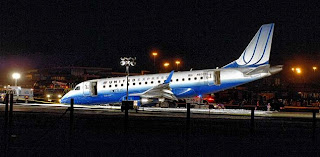The day was pretty typical at the beginning. It was the first day of a four-day trip. I woke up at 6:40, showed up at the airport around 7:45, and was at the (not yet there) airplane around 8:05 for an 8:35 departure.
We flew down to Columbus and back to Cleveland, then headed to Rochester where we sat for four and a half hours. I caught up with a good friend on the phone, talked with a couple of Captains about sailing and adventure, and wasted time on the internet to pass the time.
We finally boarded up our 5:20 flight at 5:55 for an always-late flight to Newark. Because we were late, all of our passengers had been put on other flights. We literally flew with zero passengers. We took off with me flying towards the city of never-on-time flights. I have really come to hate that place. With about 35 minutes remaining to go, we received word that Newark International Airport had been shut down. An airplane had a landing gear emergency and was still on the runway.
 |
| Sam Costanza/New York Daily News |
So while we crept along through the air, our fellow pilots were hitting their "bingo fuel," the mark at which they must divert to another airport. We hold Colgan head back to Buffalo. We heard other people (including our own) end up heading to cities in New York and Pennsylvania. They simply were running out of fuel just hanging out in the sky.
We ended up getting a hold over the WEARD intersection. So we flew in circles for about 20 minutes as we waited for the airport to open back up. We ended up doing two turns in the hold. We were still looking good on fuel, and the fuel-sippin' airplane was more than happy to fly. I commented to myself just how disorienting the night sky was, though. As we made the turns in the hold with the heavy 60-knot winds, you couldn't make out anything but black. I knew there were clouds below us (and bumpy ones at that), but the sky just wasn't visible. It was BLACK.
We were finally allowed to head to Newark and ended up landing only 47 minutes late. We had a very fun approach, though...ILS 22L circle-to-land 29. It's fun to hand-fly. We landed without incident and headed in where we learned our next airplane was one of the ones that didn't make it in.
I grabbed a much-needed dinner as we learned we were being given another plane so that we didn't "time out." Basically, with the delay of waiting for our next airplane, we were creeping up towards our 16 hours of work. Yup, you read that right. 16 hours. I won't even get in to that here, but suffice it to say, we had had a long day.
We finally boarded up our passengers for our 8:00 flight at 8:58 and flew our fifth and last leg to Syracuse. We were pretty light on passengers, though, with half of them probably not making it in to Newark in time. But we were told to shut the doors and get on out of there. Those decisions are simply out of our hands.
As we took off, we could still see the emergency aircraft disabled on 22L with tons and tons of emergency vehicles around it. It was pretty neat to see. The nosewheel didn't come down, so it landed on its main wheels only. Everything looked perfect, though. An airplane down the center of the runway with all emergency chutes deployed. There should be no injuries with that one. Well, done, sir, well done.
We finally ended up in Syracuse at 10:22, 55 minutes later than scheduled. All in all, we worked 14 hours and 27 minutes. Of course, we'll only be paid for 5.93 of those hours. But I won't get into that here, either.
Remember, this is just another day in the life. :)
A long day to start a four-day trip. A realization that sometimes it's in our favor to be running late. A couple of holds. And an appreciation for the professionalism and safety of the airplanes flying around me. An emergency with a crisis avoided.
Kudos to my fellow pilot at Shuttle America. Well done, sir. Well done.


